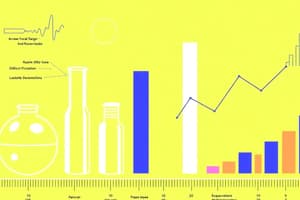Podcast
Questions and Answers
What is the main characteristic of a within-subjects design?
What is the main characteristic of a within-subjects design?
- Each participant experiences multiple conditions. (correct)
- Participants are randomly assigned to conditions.
- Participants are selected to create equivalency.
- Each participant experiences only one condition.
Which of the following is a disadvantage of a between-subjects design?
Which of the following is a disadvantage of a between-subjects design?
- Dependability of treatment effects
- Effects of repeated testing
- Need for fewer participants
- Equivalency is less assured (correct)
What do control groups help to determine in an experiment?
What do control groups help to determine in an experiment?
- The effects of the independent variable
- The need for random assignment
- The dependability of treatment effects
- The standard value of dependent variables (correct)
In a nonequivalent control group design, how are participants selected?
In a nonequivalent control group design, how are participants selected?
What is a major advantage of a within-subjects design?
What is a major advantage of a within-subjects design?
What is one of the main advantages of a between-subjects design?
What is one of the main advantages of a between-subjects design?
Which term describes participants that are not exposed to the experimental manipulation?
Which term describes participants that are not exposed to the experimental manipulation?
What defines an experimental condition in research design?
What defines an experimental condition in research design?
What is a major distinction between lab and field experiments?
What is a major distinction between lab and field experiments?
Which advantage is unique to lab experiments?
Which advantage is unique to lab experiments?
What is one disadvantage of conducting field experiments?
What is one disadvantage of conducting field experiments?
Which of the following is an advantage of lab experiments?
Which of the following is an advantage of lab experiments?
What is a limitation associated with field experiments?
What is a limitation associated with field experiments?
What is a characteristic of the Solomon Four-Group design?
What is a characteristic of the Solomon Four-Group design?
What is one reason for conducting a pretest in experiments?
What is one reason for conducting a pretest in experiments?
Which method can be used to handle baseline differences in groups?
Which method can be used to handle baseline differences in groups?
Which of the following research designs should be avoided due to its limitations?
Which of the following research designs should be avoided due to its limitations?
In a control experiment with control condition, what happens to participants in CONDITION II?
In a control experiment with control condition, what happens to participants in CONDITION II?
What is a significant drawback of the one-group pretest-posttest design?
What is a significant drawback of the one-group pretest-posttest design?
What does the analysis of difference scores aim to address in experimental designs?
What does the analysis of difference scores aim to address in experimental designs?
Which option correctly identifies a comparison that can be made in the Solomon Four-Group design?
Which option correctly identifies a comparison that can be made in the Solomon Four-Group design?
What is a characteristic of within-subjects design?
What is a characteristic of within-subjects design?
What does causal inference allow researchers to do?
What does causal inference allow researchers to do?
Which of the following is NOT a condition to infer causation?
Which of the following is NOT a condition to infer causation?
What is one of the caveats to determining causality?
What is one of the caveats to determining causality?
What is a defining characteristic of experimental designs?
What is a defining characteristic of experimental designs?
What is the purpose of random sampling in research?
What is the purpose of random sampling in research?
What does ANOVA primarily compare?
What does ANOVA primarily compare?
What technique helps to avoid bias in participant assignment to experimental conditions?
What technique helps to avoid bias in participant assignment to experimental conditions?
Which type of ANOVA employs only one independent variable?
Which type of ANOVA employs only one independent variable?
What can be expected when using correlational methods for inferring causal relationships?
What can be expected when using correlational methods for inferring causal relationships?
In an experimental design, what is the significance of differences observed between groups after the introduction of the independent variable (IV)?
In an experimental design, what is the significance of differences observed between groups after the introduction of the independent variable (IV)?
What statistical procedure is an extension of the t-test?
What statistical procedure is an extension of the t-test?
What constitutes random assignment in an experimental research design?
What constitutes random assignment in an experimental research design?
What is a characteristic of a control experiment?
What is a characteristic of a control experiment?
Which of the following describes random sampling?
Which of the following describes random sampling?
Why is randomization important in experimental research?
Why is randomization important in experimental research?
Study Notes
Experimental Research Designs
- Experiments involve manipulating variables and require random assignment to groups.
- High control over various elements of the study is characteristic of experimental designs.
Random Sampling and Random Assignment
- Random sampling ensures every population member has an equal chance of being selected; rare in applied research.
- Random assignment equalizes groups by giving each sample member an equal chance for group assignment, minimizing bias.
Types of Experimental Designs
- Control experiments compare outcomes of an experimental group and a control group, assessing effect through pretest and posttest data.
- Solomon Four-Group design allows comparison of different treatment and pretest effects; requires a larger participant pool.
Pretest Importance and Handling Differences
- Pretests promote group equivalence, establish baseline, and evaluate testing effects.
- Address baseline differences using difference scores, ANCOVA, or partial correlations.
Research Designs to Avoid
- One-group designs with no control group or proper randomization are less reliable due to potential biases and lack of equivalent control.
Within-Subjects vs. Between-Subjects Designs
- Within-subjects design allows each participant to experience all conditions, ensuring equivalence but risking testing effects and treatment dependability.
- Between-subjects design minimizes testing effects as each participant experiences only one condition, yet it requires more participants.
Key Experimental Concepts
- Control involves ruling out threats from extraneous variables, ensuring clarity on treatment effects.
- Control group participants are not exposed to the treatment for comparison with experimental group participants.
Causal Inferences
- Experimental designs enable causal inferences due to manipulation of variables.
- Three conditions for causal inference: contiguity, temporal precedence, and constant conjunction must be met.
- Causation assessment requires the use of manipulation; correlation alone does not imply causation.
Analysis of Variance (ANOVA)
- ANOVA compares two or more means simultaneously and extends the t-test framework.
- Simple ANOVA involves one independent variable, allowing for detailed examination of treatment effects.
Lab vs. Field Experiments
- Lab experiments offer high control and precision but may lack realism; replicated conditions are a major advantage.
- Field experiments provide realistic settings, generalizability of results, and insights into complex behavior, but measurement precision is often lower.
Experiment Design Considerations
- Lab settings offer control advantages but may not accurately reflect natural environments; some phenomena may be difficult to study in labs.
- Field experiments may face challenges with access and measurement but allow for exploration of behavior in real-life contexts.
Studying That Suits You
Use AI to generate personalized quizzes and flashcards to suit your learning preferences.
Related Documents
Description
Explore the key concepts of experimental research designs in this quiz. Understand how variable manipulation and random assignment play crucial roles in the methodology. Get ready to test your knowledge of experimental setups and their implications in research.




